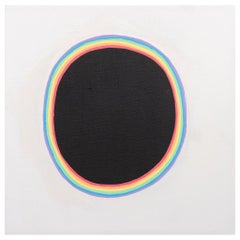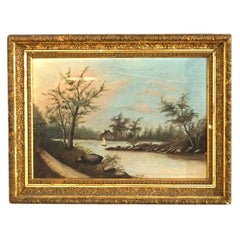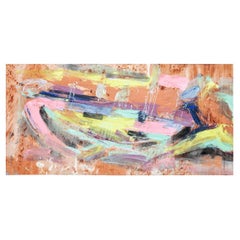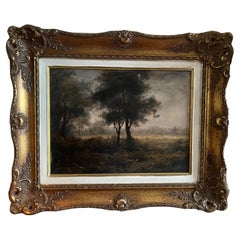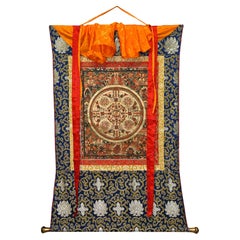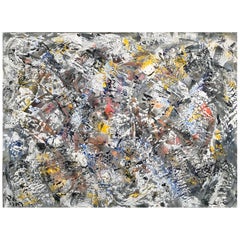Fabric Paintings
to
1,438
5,702
3,348
8,116
907
420
Height
to
Width
to
1,242
1,139
216
162
160
147
115
67
64
53
38
32
32
29
29
26
22
8
753
1,795
5,567
1,327
822
1,928
1,753
94
47
147
148
125
285
474
489
286
237
9,443
8,764
8,250
6,388
2,934
4,657
2,803
2,478
1,374
810
9,443
9,390
9,423
37
31
22
22
21
Material: Fabric
Capobianco Pop Art Rainbow Acrylic on Canvas
Located in Astoria, NY
Domenick Capobianco (American, born 1928) abstract pop art acrylic on canvas depicting a black circle on white ground surrounded by a rainbow, apparently unsigned, "Studio Domenick Capobianco" stamp to verso, unframed. 10" H x 10" W. Provenance: Property from the estate of the artist. Note: Domenick Capobianco (American, b. 1928) artist, is a graduate of Washington University at St. Louis and a Rutgers Fellow (1979) , and a Guggeheim Fellow (1984/85). Capobianco taught for many years on the faculty at Rutgers University, N.J. His work is in the collections of the Academie des Beaux-Arts, Ljubjana, Slovenia; the Sammlung Albertina, Vienna, Austria ; L’Instituto per la Culturea e L’Arte, Catania, Italy; The Kharkiv Museum, Kharkiv, Ukraine; Le Musee d’Art Contemporain, Skopje, Macedonia; The M.V. Nesterov Museum, Ufa, Russia; The Newark Public Library, Newark, NJ; The Robert Blackburn Collection, Library of Congress, Washington, DC; and the Weatherspoon Museum, Greensboro, N.C., among many others in Europe, Asia, and the U.S. Long a regular exhibitor at the famed 55 Mercer Gallery...
Category
Mid-20th Century Modern Fabric Paintings
Materials
Canvas, Paint
Antique Oil on Canvas Landscape Painting, Mountain Lake Scene, Framed, C1890
Located in Big Flats, NY
Antique Oil on Canvas Landscape Painting, Mountain Lake Scene with Country Road, Giltwood Framed, C1890
Measures- 18.75''H x 24.75''W x 2.75''D
An antique oil on canvas painting depi...
Category
Late 19th Century Antique Fabric Paintings
Materials
Canvas, Giltwood
$280 Sale Price
20% Off
Francine Tint AttributedAcrylic On Canvas Abstract Composition "After Portugal"
Located in Bridgeport, CT
A large abstract canvas with broad swaths of peach tones with yellow, blue and pink and black outlines. Unsigned.
Titled "After Portugal, 2012)"
Presented unframed in a supported str...
Category
21st Century and Contemporary American Mid-Century Modern Fabric Paintings
Materials
Canvas, Wood
Framed Oil on Board Landscape Scene, 19th Century
Located in Savannah, GA
Framed Oil on Board Landscape Scene, 19th Century. Signed Heinie Hartwic
Category
19th Century French Antique Fabric Paintings
Materials
Canvas
Tibetan Thangka of Celebration Hand Painted Gilded
Located in Somis, CA
An exquisite hand painted Tibetan Thangka depicting 63 Buddhas with consorts and 5 protector Vajrabhairavas. Buddha seated dhyana asana on lotus throne at the center of the mandala i...
Category
2010s Nepalese Fabric Paintings
Materials
Gold Leaf
$1,100 Sale Price
51% Off
Andrew Plum Winter Vortex Contemporary Abstract Painting, 2020
By Andrew Plum
Located in Montreal, QC
“Winter Vortex” is an original, one of a kind, white, yellow, black, gray, red, blue contemporary, acrylic on canvas abstract painting. Vibrant pops of color work in harmony to create this unique, contemporary work of art by Andrew...
Category
2010s Canadian Modern Fabric Paintings
Materials
Canvas
Portrait of a Sea Captain, by Charles Delin (1756-1818), circa 1810
Located in Nantucket, MA
Late 18th to Early 19th Century Portrait of a Sea Captain, by Charles Delin (Netherlands: 1756-1818), circa 1810, a fine period oil on canvas quarter-length portrait of Captain Mellens, an elegant gentleman in navy blue woolen double breasted sea coat, with high starched collar shirt and neck cloth, unsigned; retains an old collection label on the reverse identifying the artist and subject. The painting remains in fine condition, in its original carved and gilded frame.
Although identified by name, we could not find any additional information on the sitter. The name and clothing indicates that the captain was American or English. The artist Charles Delin was highly regarded in his day and specialized in sea captain portraits...
Category
1810s Dutch George III Antique Fabric Paintings
Materials
Canvas
Raphael Soyer (American, 1899–1987) Portrait of a Young Woman, c. 1940s
Located in Atlanta, GA
Raphael Soyer (American, 1899–1987)
Portrait of a Young Woman, c. 1940s
Oil on canvas - Signed lower left "Raphael Soyer"
This intimate and introspective portrait by Raphael Soyer ...
Category
Mid-20th Century American Expressionist Fabric Paintings
Materials
Canvas, Paint
18th Century, Italian painting with Saint Nicholas and the miracle of the brick
Located in IT
18th Century, Italian painting with Saint Nicholas and the miracle of the brick
Oil on canvas; Frame cm H 136 x W 109 x D 10. Canvas cm H 100 x W 74
The oil on canvas painting, with...
Category
18th Century Italian Baroque Antique Fabric Paintings
Materials
Canvas
Dutch Old Master Painting Cuyp (1612 - 1652)
By Benjamin Gerritzoon Cuyp
Located in Vero Beach, FL
17th century Dutch Old Master painting with provenance, Barnyard with farm animals and peasants.
This Dutch oil on canvas painting is a jewel among the g...
Category
17th Century Dutch Baroque Antique Fabric Paintings
Materials
Canvas
$3,250 Sale Price
50% Off
Lepoittevin Early 19th Century Marine Oil Painting
Located in 263-0031, JP
A marine tableau, oil on wood board, by the French Romantic painter Eugène Lepoittevin (1806-1870). The signature “Poitevin” appears in the lower right: our painter seems to have gon...
Category
Mid-19th Century French Antique Fabric Paintings
Materials
Canvas
Pär Lindblad, Sweden, Oil on Canvas, Modernist Landscape, 1940s
Located in København, Copenhagen
Pär Lindblad (1907-1981), Sweden. Oil on canvas. Modernist landscape.
Man on a bicycle along the coast. 1940s.
The canvas measures: 64 x 31 cm.
The fr...
Category
1940s Swedish Modern Vintage Fabric Paintings
Materials
Canvas
18th Century Old Masters Oil Painting Attributed to Claude Joseph Vernet, France
Located in Traversetolo, IT
18th century old masters oil painting attributed to Claude Joseph Vernet, France. View of a Mediterranean port at sunset. Great pi...
Category
Late 18th Century French Neoclassical Antique Fabric Paintings
Materials
Canvas
Lucien DeLarue 'French, 1927 - 2011' Oil on Canvas French Canal Scene
Located in Bridgeport, CT
Oil on canvas depicting a French canal scene in the winter with trees still bearing the last remnants their foliage while snow covers the ground. The cana...
Category
20th Century European Belle Époque Fabric Paintings
Materials
Canvas
1967 Charles Hinman Red and Orange Shaped Canvas from Richard Himmel Estat
Located in West Palm Beach, FL
Created over 50 years ago, the painting is an artwork of great historical significance. Charles Hinman was a Pioneer of shaped canvases and a leader in abstract art in the 20th centu...
Category
1960s Mid-Century Modern Vintage Fabric Paintings
Materials
Canvas, Wood
Monumental 18th Century Italian Oil Painting
Located in Round Top, TX
A monumental 18th century Oil On Canvas Painting from Lucca, Italy. Delightful soft color and hues with handsome cracquelure. The painting will be the statement of its surrounding.
Category
18th Century Italian Antique Fabric Paintings
Materials
Canvas
Knud Horup (1926-1973), Danish artist. Oil on canvas. Figure in landscape.
Located in København, Copenhagen
Knud Horup (1926-1973), Danish artist.
Oil on canvas. Figure in landscape.
Mid-20th century.
Signed.
In perfect condition.
Dimensions: 70 cm x 60 cm.
Total with frame: 81 cm x 71 cm.
Category
Mid-20th Century Danish Modern Fabric Paintings
Materials
Canvas
Large Painting Woman in the Sea, Blue Oil on Canvas
Located in Miami, FL
This evocative oil painting depicts a woman standing defiantly amidst a turbulent sea. Clad in flowing white garments, she reaches her hands skyward, her face turned upwards in a ge...
Category
20th Century American Mid-Century Modern Fabric Paintings
Materials
Canvas, Wood, Paint
Taxi Surrealist Painting Clowns Signed Alfano Dardari
Located in Long Island City, NY
Oil on canvas painting representing two clowns riding a unicycle in an empty field. Signed Alfano Dardari in the lower right. Titled Taxi on the frame. ...
Category
20th Century Italian Fabric Paintings
Materials
Canvas
$1,500 Sale Price
50% Off
The Spring Oil Painting After Ludwig Knaus (German, 1829-1910)
Located in New York, NY
Lovely copy of the original painting, The Spring, by the German master, Ludwig Knaus (German, 1829-1910), mounted in its original and truly magnificent ornate giltwood frame measurin...
Category
Late 19th Century Italian Belle Époque Antique Fabric Paintings
Materials
Canvas
Preben Fjederholt "San Cataldo" Oil on Canvas
Located in Kastrup, DK
Preben Fjederholt 1955 - 2000.
San Cataldo Italy.
Oil on canvas, without frame: 36 x 41.
Provenance: Decedent's estate.
The work is one of several in the artist's studio at the time of his sudden death on 3 July 2000.
Measurement (cm) With frame H: 38 x 43 x 3 without frame: 36 x 41.
Danish painter, from 1974 educated at the art academies in Odense, Aarhus and Copenhagen.
Preben Fjederholt, who made his debut at Kunstnernes (The Artist's) Fall exhibition 1980, is an exponent of a neo-romantic and neo-symbolist depiction of reality in his atmospheric and colouristically muted paintings.
Category
Early 2000s Danish Scandinavian Modern Fabric Paintings
Materials
Canvas
Early 20th c English School Oil Painting Dock & Fishing Boats by Frederick Stead
By Frederick Stead
Located in Savannah, GA
English school, oil on canvas fishing boats alongside dock signed by English portrait and landscape painter Frederick Stead, (1863-1940). Antique wooden frame. Great subtle color and...
Category
Early 20th Century English Other Fabric Paintings
Materials
Canvas, Fruitwood
Surreal California Seascape Painting by Robert Watson, 20th Century
Located in San Francisco, CA
Framed Surrealist Seascape painting, oil on canvas with linen matting by California artist Robert Watson.
Titled #27 Shoreline.
Retains the original paper label from a San Francisco ...
Category
20th Century American Mid-Century Modern Fabric Paintings
Materials
Canvas, Paint
18th Century Religious Painting of a Nun Painted in Oil on Canvas Framed
Located in Marbella, ES
18th Century Religious Painting of a Nun Painted in Oil on Canvas Framed
Category
18th Century Spanish Antique Fabric Paintings
Materials
Canvas
Signed Oil on Canvas by French Artist Jean Hubert Gautier
Located in Redding, CT
Signed Oil on Canvas by Jean Hubert Gautier (1872-1930). Nice heavy impasto technique of a classic french riverscape. The composition includes heavy clouds with a basilica in the bac...
Category
Early 20th Century French French Provincial Fabric Paintings
Materials
Canvas, Wood, Paint
$940 Sale Price
47% Off
American School Oil On Canvas Laid On Board, "Ladies In A Carriage Saluted"
Located in Bridgeport, CT
American school oil on canvas laid down on board depicting two ladies in a horse driven carriage. The ladies are being saluted by a gentleman on horseback in black attire. The carria...
Category
19th Century Victorian Antique Fabric Paintings
Materials
Canvas, Wood
Oil on Canvas Painting of a Seidenspitz Dog
Located in Essex, MA
A painting of a champion Seidenspitz. Standing on an oriental carpet with bouquet of flowers.
Category
Late 19th Century German Antique Fabric Paintings
Materials
Canvas, Paint
American Impressionist landscape study, 1950's
Located in Kenilworth, IL
Unsigned oil on canvas California plein-air Impressionist landscape study of a California cypress tree on the fence line of a field. The palette is ...
Category
Mid-20th Century American Fabric Paintings
Materials
Canvas, Paint
Large and Striking Antique French Oval Nature Morte Floral Oil Painting, C. 1850
Located in Dallas, TX
A master-level painting surrounded by a thick and detailed gold leaf frame, this large oval oil on canvas has an impressive scale for a nature morte (still-life) painting. The painting, which dates to circa 1850, is by an unknown, yet extremely talented French artist. In stark contrast to the dark gray background, the subject of the painting is a brightly colored floral bouquet. The vibrant flowers (blue, red, yellow, pink, and white) reside in a brown woven basket that sits atop a stone baluster railing. A cluster of darkly colored grapes is strewn across the top of the railing, next to the basket, as two butterflies flutter above the bouquet. If you look closely, you will even see a third butterfly perched on one of the large green leaves that accompany the irises, carnations, and sunflowers. The equally impressive original frame is adorned with rings of beading, foliate rinceaux, and spiral fluting, with a deep convex molding carved with additional fluting.
In 19th-century France, an entire school devoted to floral still-life paintings emerged, located in Lyon, which was the capital of floral design. Although originally still-life art was classified as unimportant, acceptance by art historians of the 20th century elevated the public opinion of nature mortes. A painting such as our large and striking oval floral...
Category
Mid-19th Century French Antique Fabric Paintings
Materials
Textile, Canvas, Wood, Giltwood, Paint
Oil on Canvas Depicting a Porcelain Sales Woman, Chinese School, 18th Century
Located in Langweer, NL
Interesting 18th century painting, Chinese School, for the European market, depicting a porcelain sales woman dealing with European traders.
Medium: Oil on canvas. Measures: 62.5 x...
Category
18th Century Chinese Antique Fabric Paintings
Materials
Canvas
$18,081 Sale Price
47% Off
Antique Flower Painting, Dahlias Flowers, Oil on Canvas, 19th Century 'QF483'
Located in Breganze, VI
Flowers artwork, antique oil painting, floral vase painting which represents Dahlias and
Chrysanthemums. The painting has a gold leaf frame realised in the 1800s.
The oil on canvas...
Category
19th Century French Napoleon III Antique Fabric Paintings
Materials
Canvas
18th Century "Highflyer" Painting by John N. Sartorius
By John Nost Sartorius
Located in Los Angeles, CA
Fine "Highflyer" painting by John N. Sartorius. John Nost Sartorius, was an English painter of horses, horse-racing and hunting scenes, 1759-1828.
Measures: Width of the frame 2.25".
Category
1790s English Antique Fabric Paintings
Materials
Canvas, Wood
Framed Korean Jakhodo Tiger and Magpie Folk Painting One of the Four
Located in Atlanta, GA
A Korean Folk Art painting watercolor on silk mounted with brocade border and framed. The watercolor was likely dated from late 19th century to the tur...
Category
Late 19th Century Korean Folk Art Antique Fabric Paintings
Materials
Brocade, Silk, Wood
L. Royer, Oil on canvas "Thwarted Love" , France, dated 1882 (?)
Located in PARIS, FR
Signed Lionel Royer and dated 1882 (?)
Former Salon exhibition label at the top right, n°538
Indication of an exhibition in Lyon on the back of the frame, n°163
Beautiful painting ...
Category
1880s French Romantic Antique Fabric Paintings
Materials
Canvas
Untitled Work by Scott Kerr
Located in Dallas, TX
Scott Kerr is a self-taught Contemporary Abstract Artist. As a young boy, he was exposed to the art world by his father through the works of a local Texas artist, David Brownlow. Ama...
Category
20th Century Organic Modern Fabric Paintings
Materials
Canvas, Paint
A Medieval Battle Scene Antique Original Oil Painting, Early 20th Century
Located in Bristol, GB
Antique Original Oil on Canvas Painting
A wonderfully energetic depiction of an Eastern battle scene, probably depicting the medieval Crusades including knights on horseback, pikem...
Category
Early 1900s Antique Fabric Paintings
Materials
Canvas, Paint, Wood
Italian 18th Century Oil on Canvas from the Piedmont Region
Located in West Palm Beach, FL
A sensational and large scale Italian 18th century oil on canvas from the Piedmont region. The beautiful painting is set in its original polychrome frame which displays a lovely carv...
Category
18th Century Italian Antique Fabric Paintings
Materials
Canvas, Wood
Mid-century Overscale Abstract Beach Scene Oil Painting, Signed, 1962
Located in Miami, FL
Mid-century Overscale Abstract Beach Scene Oil Painting, Signed, 1962
Offered for sale is a bold and vibrant oversized abstract oil painting on canvas depicting three figures at the...
Category
Mid-20th Century American Mid-Century Modern Fabric Paintings
Materials
Canvas, Paint
19th Century Still Life with Fruits Painting Oil on Canvas
Located in Milan, IT
Nineteenth century.
Still life with fruits.
Oil on canvas, 64 x 52 cm.
The still life analyzed presents a mixture of floral and fruit elements arranged in a circular order o...
Category
19th Century Italian Antique Fabric Paintings
Materials
Canvas
19th Century Spanish Orientalist Framed Oil on Canvas Painting
Located in Marbella, ES
19th Century Spanish Orientalist Framed Oil on Canvas Painting
Measurements with frame: 61.5x72.5x4cm.
Category
Mid-19th Century Spanish Antique Fabric Paintings
Materials
Canvas, Wood
Mid-Century Modern Artwork Painting, circa 1977
Located in Barcelona, ES
Unframed midcentury artwork painting signed by Queralt. Material: Oil, canvas Manufactured in Spain, circa 1977. Dimensions: D 1.8 W 73 H...
Category
1970s Spanish Modern Vintage Fabric Paintings
Materials
Canvas, Paint
$523 Sale Price
74% Off
Vintage Spring Desert Landscape Painting
Located in Los Angeles, CA
Vintage Desert landscape painting floated in a simple blonde wood frame depicting a spring superbloom in the foreground with cactus ...
Category
Late 20th Century North American Modern Fabric Paintings
Materials
Canvas, Wood, Paint
$1,120 Sale Price
20% Off
Important 1944 Surrealist Oil on Canvas by Erle Loran
By Erle Loran
Located in Minneapolis, MN
Fresh to the market, this painting was purchased directly from Erle Loran (1905-1999) in his Berkeley Hills home in the mid-1990s. Loran's surrealist work from the mid-1940s is highl...
Category
1940s American Mid-Century Modern Vintage Fabric Paintings
Materials
Canvas, Wood, Paint
Mid twenty century framed still life oil painting fruits on a table
Located in Birmingham, AL
Vintage framed still life oil painting of fruits and table, the colours are vibrant and refreshing. It will turn heads and it will add charm to any wall decor. The painting very h...
Category
Mid-20th Century American Art Deco Fabric Paintings
Materials
Canvas
Michael Hedges "Studio Sunday" Oil Painting on Canvas
Located in New York, NY
Michael Hedges "Studio Sunday" oil on canvas 52" x 42" in 2021.
Michael Hedges, born 1976.
Michael's art connects on a cosmic plane with the Abstract ...
Category
21st Century and Contemporary American Expressionist Fabric Paintings
Materials
Canvas, Paint
Mid Century Abstract Still Life Painting
By Lentz
Located in San Francisco, CA
Large oil painting on canvas still life in original wood frame, signed Lentz.
Category
20th Century Mid-Century Modern Fabric Paintings
Materials
Canvas
Magnus Engstrom Signed Swedish California Artist Mid-Century Modern Oil Painting
By Magnus Engstrom 1
Located in Studio City, CA
A wonderful and quite colorful oil on canvas painting by Swedish-American California artist Magnus Engstrom (1936- ).
The painting features a futurist cityscape and is done in the neo-cubist abstract expressionist artistic painting style that Engstrom embraced.
The painting is signed and dated (1970) by Engstrom.
Would be a great addition to any Mid-Century Modern or California art painting collection...
Category
1970s American Mid-Century Modern Vintage Fabric Paintings
Materials
Canvas, Wood, Paint
German 17th Century Painting Of The Madonna
Located in Round Top, TX
An exquisite 17th century oil painting of the Assumption Of The Virgin Mary. Magnificently executed in oil on a hand woven canvas. Stunning.
Category
Mid-17th Century German Antique Fabric Paintings
Materials
Canvas
Oil Painting of Terriers Ratting in a Barn, Signed George Armfield, circa 1850
Located in Atlanta, GA
An animated and richly detailed 19th-century oil on canvas depicting three terriers in the midst of a hunt, this genre scene is attributed to British painter George Armfield (c.1850)...
Category
Mid-19th Century English Antique Fabric Paintings
Materials
Canvas, Giltwood
Seated Woman & Persian Rug Oil on Canvas Painting by Israeli Zvi Olivitzki, 1960
Located in Philadelphia, PA
A fine Israeli oil on canvas painting.
By Zvi Olivitzki (b. 1930, Haifa.)
Depicting a woman with a floral skirt seated before a geometric Persian rug on a patterned upholstered chair...
Category
1960s Israeli Mid-Century Modern Vintage Fabric Paintings
Materials
Canvas, Paint
Vibrant Mid-Century Modern Abstract Acrylic Painting on Canvas by Jane Potash
Located in Philadelphia, PA
A beautiful work done by Philadelphia Artist Jane Potash. All original work with signature on front and original frame. Not dated, probably created late 19...
Category
1970s American Mid-Century Modern Vintage Fabric Paintings
Materials
Canvas, Acrylic
Oil Painting - Lions in a Savannah Landscape - Paul Daxhelet
Located in Casteren, Noord-Brabant
A beautiful oil painting, lions in an African savannah landscape. Nice composition with a special atmosphere and beautiful use of colors. The painting is framed in a beautiful wooden...
Category
1950s Belgian Vintage Fabric Paintings
Materials
Canvas, Wood
Canadian School Winter Landscape Oil Painting, Unsigned, Framed, Early 20th C
Located in Chatham, ON
Antique Canadian school 'winter landscape with stream' oil painting on artist's board/panel - original pine frame with gilt and painted finish - unsigned/untitled (pencil note on fra...
Category
Early 20th Century Canadian Romantic Fabric Paintings
Materials
Canvas, Softwood, Paint
$416 Sale Price
30% Off
Vintage Framed and Signed Painting of Wolves in the Woods.
Located in Seattle, WA
Vintage Painting on Canvas, Signed in the Lower Corner as Pictured. Textured Paint.,Particularly on the Wolves. Complimented Well with the ...
Category
1970s Mid-Century Modern Vintage Fabric Paintings
Materials
Canvas, Wood
Pair of American Oil on Canvas Gilt Framed Portraits, S.C., Circa 1770
Located in Charleston, SC
Pair of American oil on canvas portraits in the original floral gilt frames and stretchers. South Carolina, Late 18th century. Signed Dr. Anthony Hemingway on re-verso.
Category
1770s American American Colonial Antique Fabric Paintings
Materials
Gold Leaf
Antique Pair of Coastal Scene Maritime Oil Paintings 19th Century
Located in London, GB
This is a beautiful pair of antique gilt framed maritime oil on canvas paintings in the style of William Sadler, dating from the mid 19th Century.
Both paintings depict coastal scen...
Category
Mid-19th Century Antique Fabric Paintings
Materials
Canvas, Giltwood
Barbizon School Painting, Jules Dupré "Landscape by the River", Oil on Canvas
By Jules Dupré
Located in Montreal, Quebec
Rare, large and very beautiful oil painting by Jules Dupré (1811-1889), a French artist famous for his dramatic paintings of forests around Paris and one of the leaders of the Barbiz...
Category
19th Century French Barbizon School Antique Fabric Paintings
Materials
Canvas, Wood
$118,400 Sale Price
20% Off
Japanese Bijin-ga Painting of Woman in Period Kimono, Taisho Period, circa 1920
Located in Prahran, Victoria
Rare Japanese Taisho period Bijin-ga style painting of a beautiful woman in period kimono holding a fan, circa 1920.
Bijin-ga is a Japanese term used to describe paintings or pict...
Category
1920s Japanese Taisho Vintage Fabric Paintings
Materials
Silk
"Basura En La Ciudad" Abstract Artwork By Mexican Artist Maricruz H. Covarrubias
Located in New York, NY
"Basura En La Ciudad" Acrylic on canvas abstract artwork by Mexican artist Maricruz Hernadez Covarrubias 1947-2016
Painting measurements: width 47'' height 35.25''
"Maricruz H. Cov...
Category
1980s Mexican Mid-Century Modern Vintage Fabric Paintings
Materials
Canvas, Acrylic
Mid Century Signed Abstract Still Life Titled "Spring Flowers"
By Richard C. West
Located in Redding, CT
Mid Century signed Abstract Still Life titled "Spring Flowers" by Richard C. West Signed and dated 1965. Nice impasto style technique. Tones of Olive green, yellow, gray and light bl...
Category
1960s American Mid-Century Modern Vintage Fabric Paintings
Materials
Canvas, Wood
$1,200 Sale Price
45% Off
Recently Viewed
View AllMore Ways To Browse
Sterling Chamberstick
Sterling Holloware
Sterling Silver Chamberstick
Sterling Silver Hip Flasks
Sterling Silver Holloware
Sterling Silver Pin Cushions
Sterling Tea Set Tray Kettle
Streamline Dresser
Sugar Plum
Syrian Chest
Tall Acrylic Vase
Tapio Wirkkala Paper Bag Vase
Tapio Wirkkala Paper Bag
Teak Nutcracker
Thomasville Oak
Thonet Cafe Table
Tibetan Altar
Tibetan Artifacts
